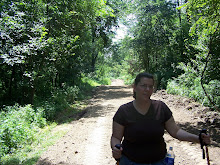
I’ve started this review about ten times now and keep stopping. I picked the story up on a whim and loved it. But so far I’m having a hard time capturing exactly what I want to say about this wonderfully little story about following your happiness.
This is the story of Hector McGregor who everyone calls Inventor McGregor. He is called that because of his amazing ability to invent whatever is needed. He invents barking mailbags so the postman won’t be attacked by a neighborhood dog. He invents an alarm clock that pushes people off their pillow (for those frequent snoozers). He invents things like robotic arms, trampoline shoes, floating bags, and peppermint pens. He can invent anything. When not inventing, he lives with his cheerful wife, five children, and a hen named Hattie. He goes for walks and paints and plays the fiddle and is very happy. One day he is discovered by the Society of Inventors and is given a laboratory in the city and a job. He reluctantly heads for the city to start inventing full time. But he can’t think of anything to invent. Days, weeks, months go by and he hasn’t invented anything. He sits in his empty room all day and can’t think of a single thing. People stop calling him Inventor McGregor. As the weeks go by he becomes more depressed until he sees two men painting outside the window. He rushes out and grabs two paintbrushes and he paints. He paints his wife, his children, and Hattie. He paints the sun and the meadow. And then he leaves the city, rushes home, and goes back to his days of singing, painting, walking, and…inventing.
I loved this book, which was written by Kathleen Pelley and illustrated by Michael Chesworth. I loved the character of Inventor McGregor with his bright red hair, glasses, and regular smile. He simply jumps off the page with enthusiasm and the reader is helpless to not get caught up in it. I found myself smiling through the whole first half of the book. The colors, which I believe are watercolor, make the early spreads bright and beautiful. We see the excitement of everyone in the village and the joy that seems to radiate out of the inventor’s house. The words practically bounce off the page in the first half. As an example, Pelley uses this line to describe Inventor McGregor’s day out in the field. “There he sang his snippet of a song, painted a picture, or twirled a whirl of a fling.”
This is all in the first half of the book though. On that very page that I referenced above we see darker clouds rolling in. Chesworth creates the transition in the book perfectly. When the Society of Inventors guys arrive it is raining. The trains into the city are dirty and depressing. We see one lonely red haired man peering out as he heads into the city. Where Hector used to be the epitome of energy, his arms now hang limp. He slumps more. There is a great two page spread that shows his frustration with trying to create. We see him in several different poses at his inventing desk, each a perfect character study of boredom. Pelley also makes the transition beautifully. Suddenly we go from wonderful descriptions of the fields to as few words as possible. And Pelley starts using words like shame, frown, and whispered. The words become slower and less descriptive. The pace of the book actually slows down…until he gets those paint brushes in his hands. Suddenly the colors are back, the descriptive words are back and the joy is back. We, along with Hector, feel the excitement of realizing what makes him happiest.
This was a fun book that made me so incredibly happy. I loved the transitions between the home and city environments. I loved the colors and the emotions that were so evident on our characters faces. I enjoyed the character of Inventor McGregor quite a bit. And more than anything I love how enthused I got after reading it. Like the inventor, I too wanted to paint and sing and create.








 A couple years ago while digging around in my parent's children's book library I stumbled upon a version of The Spider and the Fly, the cautionary poem by Mary Howitt. The poem itself is fun and dark but the illustration in the book took my breath away. They were amazing. Funny and dark and detailed in a way I hadn't seen before. The spider oozed charm and menace. The fly, in her little flapper dress and hat, was the picture of flighty innocence. The ghosts, who tried to warn the fly, practically shimmered on the page. It was a beautiful book. At the time I noticed that it was done by Tony Diterlizzi but then promptly forgot.
A couple years ago while digging around in my parent's children's book library I stumbled upon a version of The Spider and the Fly, the cautionary poem by Mary Howitt. The poem itself is fun and dark but the illustration in the book took my breath away. They were amazing. Funny and dark and detailed in a way I hadn't seen before. The spider oozed charm and menace. The fly, in her little flapper dress and hat, was the picture of flighty innocence. The ghosts, who tried to warn the fly, practically shimmered on the page. It was a beautiful book. At the time I noticed that it was done by Tony Diterlizzi but then promptly forgot.

